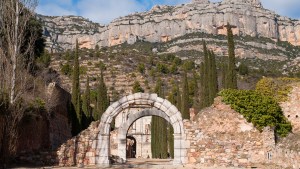Of the many monastic orders born out of the devotion of different saints, the Carthusian order stands out for its dedication to contemplation, solitude and silence. Founded in 1084 by Bruno of Cologne, the order embraces the motto Stat crux dum volvitur orbis, Latin for “The Cross is steady while the world turns,” reflecting the order’s sense of detachment from worldly affairs and firm anchor in God.
Each Carthusian charterhouse is headed by a prior overlooking the activities of monks, who are divided into hermits and lay brothers. The essence of Carthusian monasteries is to provide a place for shared solitude, reflection, and contemplation. Founded in 1960, the Charterhouse of the Transfiguration is the only Carthusian monastery in the United States.
As explained by Professor Kent Emery of Notre Dame University, the monastery came into being following the combination of some factors unique to the establishment of American Catholic monasteries or churches: the patronage of wealthy lay people; the early pioneer activities of monks from old European houses; and the discovery of a proper place, usually in a remote location, to establish a place of worship.
As Emery explains, the roots of the Charterhouse of the Transfiguration go back to the 1950s. That’s when Dom Pablo Maria, probably the first American Carthusian, and the Spanish Carthusian Prior of the Charterhouse of Jerez, Dom Luis Maria, met with the intention of founding the first Carthusian monastery in the New World. The duo were soon joined in their efforts by two monks from the Charterhouse of Parkminster, Dom Humphrey and Brother Bede.

The four monks explained their project to Miss Elizabeth Pierce, a lay woman who later became a Carmelite nun, who was moved by the monks’ intention and provided them with 500 acres of land in Whitingham in southern Vermont. Some 800 adjoining acres were later offered to the Carthusians by Peter Grace, heir of the famous shipping company.
The monks later acquired an additional 2,000 acres in this idyllic corner of Vermont, establishing a foundation for the first Carthusian community in the US. The new community, mostly made up of monks coming from Europe, lived here for nearly 10 years.

In 1960, one of the brothers had a chance encounter with the inventor of vinyl and head of chemical firm Union Carbide, Dr. J.G. Davidson. Davidson had recently purchased a property near Arlington, Vermont, on top of Mount Equinox.
As Emery says, when Davidson visited the Carthusian community at Whtingham he was so impressed by their piety that he offered his newly established property to the monks. Between 1967 and 1970 the monks built “The Charterhouse of the Transfiguration” on top of Mount Equinox, using monolithic blocks of Vermont granite. They have been living there ever since, following the rules established by their founder Bruno of Cologne in 1084.
The physical structure of the monastery reflects the values of Carthusian life. The hermitages of the fathers lie in one wing while the cells of the brothers and the work areas are in another wing. These two areas are united by a common cloister that reaches a shared area where a church, minor chapels, a refectory, and Chapter House are found.
Unlike monasteries of other orders, the Charterhouse of the Transfiguration is not open for visitors and can only be accessed for vocational contacts.



